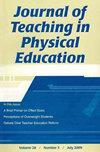环境干预对高中生扩大体育活动规划参与和活动水平的影响
IF 1.8
2区 教育学
Q2 EDUCATION & EDUCATIONAL RESEARCH
引用次数: 0
摘要
部分综合学校体育活动规划(CSPAP)近年来得到了广泛的研究。然而,几乎没有证据表明这种干预措施在高中环境中的有效性和可行性。体育教师教育(PETE)项目在为未来的体育工作者准备CSPAP实施方面进展缓慢。因此,本研究的目的是评估皮特实习生在高中实施部分CSPAP干预的效果。方法:使用直接观察仪器在三所高中收集了开学前和在校期间的数据。干预包括PETE实习生在学校驻校老师的协助下提供体育活动区、设备和监督。采用混合多基线研究设计来评估干预对高中学生在部分CSPAP会话期间的参与和中度至剧烈体育活动水平的影响。数据分析采用标准的可视化分析和辅助的统计处理。基于在实验阶段和学校收集的观察者间协议数据,数据被认为是可信的;这些数据被认为是可信的。结果:在干预开始后,在部分CSPAP课程期间从事中度至剧烈体育活动的学生总数大幅增加,从而建立了实验控制。与女孩相比,男孩表现出更多的中度到剧烈的身体活动。讨论/结论:高中生对部分CSPAP干预的反应与小学生和初中生相似,从而加强了CSPAP型干预的推广。此外,PETE实习生可以成功地在高中环境中实施部分CSPAP。本文章由计算机程序翻译,如有差异,请以英文原文为准。
Effects of an Environmental Intervention on High School Students’ Expanded Physical Activity Programming Participation and Activity Levels
Partial Comprehensive School Physical Activity Programming (CSPAP) has been studied extensively in recent years. However, there is little evidence on the efficacy and feasibility of such interventions in high school settings. Physical education teacher education (PETE) programs have been slow in preparing future physical educators for CSPAP implementation. Therefore, the purpose of this study was to assess the effects of PETE interns implementing a partial CSPAP intervention in high schools. Methods: Data were collected at three high schools during before- and during-school time periods using a direct observation instrument. The intervention consisted of PETE interns providing access to physical activity areas, equipment, and supervision with assistance from the schools’ resident teachers. A hybrid multiple baseline research design was used to assess the effects of the intervention on high school students’ participation and moderate to vigorous physical activity levels during the partial CSPAP sessions. Data were analyzed using both standard visual analysis of graphically plotted data and supplementary statistical treatments. Data were deemed credible based on interobserver agreement data collected across experimental phases and schools; the data were deemed trustworthy. Results: Experimental control was established as the total number of students engaged in moderate to vigorous physical activity during the partial CSPAP sessions increased substantially upon the start of the intervention. Compared with girls, boys demonstrated higher amounts of moderate to vigorous physical activity. Discussion/Conclusion: High school students respond similarly to a partial CSPAP intervention as do elementary and middle school-aged students, thereby strengthening the generalization of CSPAP-type interventions. Moreover, PETE interns can be successful in implementing a partial CSPAP in high school settings.
求助全文
通过发布文献求助,成功后即可免费获取论文全文。
去求助
来源期刊
CiteScore
4.20
自引率
21.40%
发文量
69
审稿时长
>12 weeks
期刊介绍:
The Journal of Teaching in Physical Education (JTPE) features peer-reviewed research articles based on classroom and laboratory studies, descriptive and survey studies, summary and review articles, and discussion of current topics of interest to physical educators at every level. JTPE is endorsed by the Curriculum and Instruction Academy of the National Association for Sport and Physical Education and the International Association for Physical Education in Higher Education.

 求助内容:
求助内容: 应助结果提醒方式:
应助结果提醒方式:


